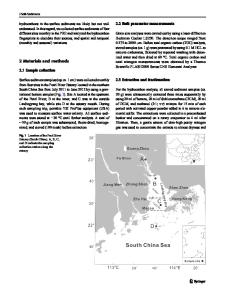Polybrominated diphenyl ethers in surface sediments from principal watersheds of Shanghai, China: levels, distribution,
- PDF / 460,600 Bytes
- 10 Pages / 595.276 x 790.866 pts Page_size
- 86 Downloads / 438 Views
RESEARCH ARTICLE
Polybrominated diphenyl ethers in surface sediments from principal watersheds of Shanghai, China: levels, distribution, influencing factors, and risk assessment Ming-Hong Wu & Liang Tang & Gang Xu & Jing Ma & Ning Liu & Liang Wang & Jian-Qiu Lei Received: 7 June 2012 / Accepted: 27 August 2012 / Published online: 19 September 2012 # Springer-Verlag 2012
Abstract Fourteen and 17 sediment samples were collected from three main rivers of Shanghai in July and November, respectively. Eight polybrominated diphenyl ether (PBDE) congeners (BDE-28, BDE-47, BDE-99, BDE-100, BDE153, BDE-154, BDE-183, and BDE-209) were detected in these samples to clarify the pollution status in the metropolis. Instrumental analyses showed that the concentrations of ∑8PBDEs ranged from 10.97 to 64.05 ng/g dry weight (dw), with an average value of 29.71 ng/g dw. BDE-209 was the predominant congener accounting for more than 97 % of total PBDEs, followed by BDE47 and BDE-99. Remarkable spatial and seasonal distributions of PBDE concentrations were observed, suggesting that local sources, seasonal climates, and hydrologic conditions might be the influencing factors. Moderate correlations (r2 0 0.28–0.51, pYunzao Creek. Among all the sampling spots, relatively high concentrations were detected in H3, H4, and H5 of Huangpu River, and in S1 and S4 of Suzhou Creek. Through an analysis of the surrounding condition enclosing those sampling spots, we found that the high concentration levels in these locations are reasonable. Spots H3, H4, and H5 are found to be adjacent to two technological development zones of Shanghai both engaging in electronics and electrical equipment industries; spot S1 as mentioned above is near SIAC (Fig. 1). Thus, two major industries, electronics/electrical and automobile industries, may contribute the great mass of PBDE inventory in Shanghai. Besides, spot S4 is located in the central city of Shanghai, which is one of the most densely populated urban districts in the world. Consequently, handling and consumption of PBDE-containing products would be expected to be more intense in the specified geography, which reasonably explains the high level of PBDEs measured in S4. The density of consumption might be the other factor influencing spatial distributions of PBDEs in Shanghai, except for the industry factor. The distinct concentrations dispersing throughout different sampling spots agree with the fact that there are some various local point sources of PBDEs in Shanghai. We have plotted the ∑8PBDE concentrations in July and November to describe the specific seasonal trends (Fig. 3). It could be found that there is no significant difference between the concentrations in July and those in November (paired t test, p>0.05). However, there is a larger varying concentration range in summer among those sampling spots. With fluctuating rainfall in July, uncertain amounts of PBDEs would be transported
Fig. 3 Box plots of ∑8PBDE concentrations in sediment samples collected in July (n014) and November (n017). The horizonta
Data Loading...











